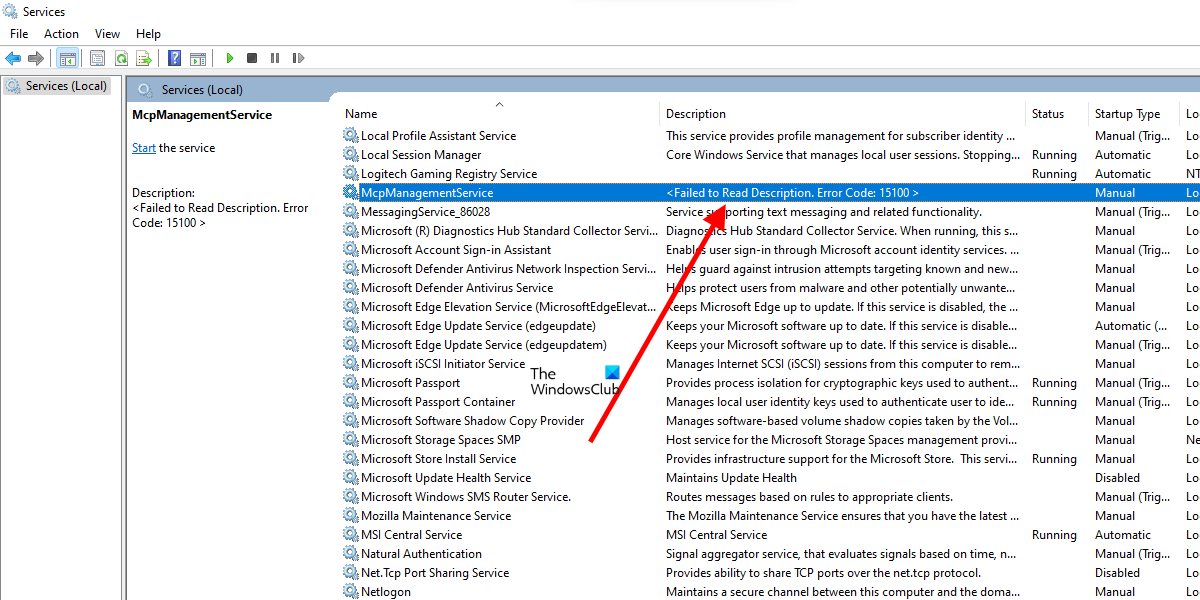Fix McpManagementService Error Code 15100 on Windows 11
On Windows 11, you may see the “Failed to read description, Error Code: 15100” error message in the description of McpManagementService. The error message is not limited to Windows 11, as some Windows 10 users have also seen the same error message in the Services Manager app. Every Service in Windows operating system has the following four startup types. Before we discuss this error in detail, it will be better if you understand these four Startup types.
Automatic (Delayed Start): If a Service is set to Automatic (Delayed Start), it starts a few minutes after the system starts (maybe 1 or 2 minutes later).Automatic: If a Service is set to Automatic, it starts automatically when you start your system.Manual: If a Service is set to Manual, you may find it running or stopped on your system. A Service in manual mode does not start by itself on the system startup. Windows can start it whenever required.Disabled: Disabling a particular Service stops it permanently and it will not start until you enable it again.
You can change the startup type of a Service via the Services Manager app. Apart from the above four Startup types, you may see two more Startup types, Automatic (Trigger Start) and Manual (Trigger Start). Trigger Start means that the service can be started or stopped by operating system events.
There is a DLL file in the Windows operating system named McpManagementService.dll. It belongs to McpManagementService. You will find this file at the following location on your system:
If you open the properties of the McpManagementService.dll file and go to the Details tab, you will see the Universal Print Management Service in its File Description. If you are wondering whether the McpManagementService.dll file is safe or not. It has a copyright of Microsoft Corporation which means it is a genuine file and not a virus or malware. The Universal Print Management Service can be used to support remote printing. Universal Print is a modern cloud-based print solution that provides robust and centralized print management capabilities and a straightforward user experience to Microsoft Office 365 users. By default, the McpManagementService is stopped. You can check this in the Services Manager app. Follow the steps below:
Since the Startup type of McpManagementService is manual and it is stopped by default, you are not using this feature or this Service is not running on your system. If it is not running and you are not experiencing any issues on your system, you can leave it as is. The users who saw this error message in the Services Manager app stated that they did not experience any issues on their systems, hence, they left it as is. As we have explained earlier in this article Manual Services can be started by the operating system whenever needed. If you use the Universal Print feature, Windows may start the McpManagementService (if required). The “Failed to read description, Error Code: 15100” error message in the Description of a Service also occurs when the particular Service fails to read its description or when the description string is not present. Now, it is clear that the error message does not cause any issues with your system. But if you want, you can repair the System Disk Image using the DISM Tool. Also, running the antimalware scan does not make any sense here, as the McpManagementService.dll file is signed by Microsoft. Hence, it is a genuine file located in the System32 folder and not a virus or malware. Read: Windows could not connect to the System Event Notification Service.
How do I find Windows 11/10 error codes?
When an error occurs on a Windows device, it creates its log and saves it. These crash logs contain the crash information, such as the error code, error description, date and time when the error occurred on your system, etc. Event Viewer is a built-in application in Windows devices to view all error logs. You can view Windows error codes in Event Viewer.
How do I get rid of CDPUserSvc?
The CDPUserSvc stands for Connected Device Platform User Service. It is a part of CDPSvc, which is a Connected Devices Platform Service. As the name implies, it is a Service that manages the connected devices. When we say connected devices, we mean the devices that are connected to each other via a medium. This medium can be a wire, a USB cable, or a network, like Bluetooth. You will find the Connected Devices Platform Service in the Services app. You can read the description of this service under the Description column in the Services Manager app or by opening the properties of CDPSvc. Its description says, “This service is used for Connected Devices Platform scenarios.” The description is not very clear. However, it lets us know that the service manages the connected devices. The CDPUserSvc is one of the Windows Services. Therefore, you cannot get rid of it. However, you can disable it, but it is not recommended as it manages the connected devices, like printers, storage devices, Bluetooth devices, etc. Therefore, if you disable this service, you may experience issues with these devices. If CDPUserSvc or CDPSvc shows high disk usage, you can disable it via the Windows Services Manager, Command Prompt, or Registry Editor. I hope this helps. Read next: Client License Service (ClipSVC) service terminated unexpectedly, Error 1067.
